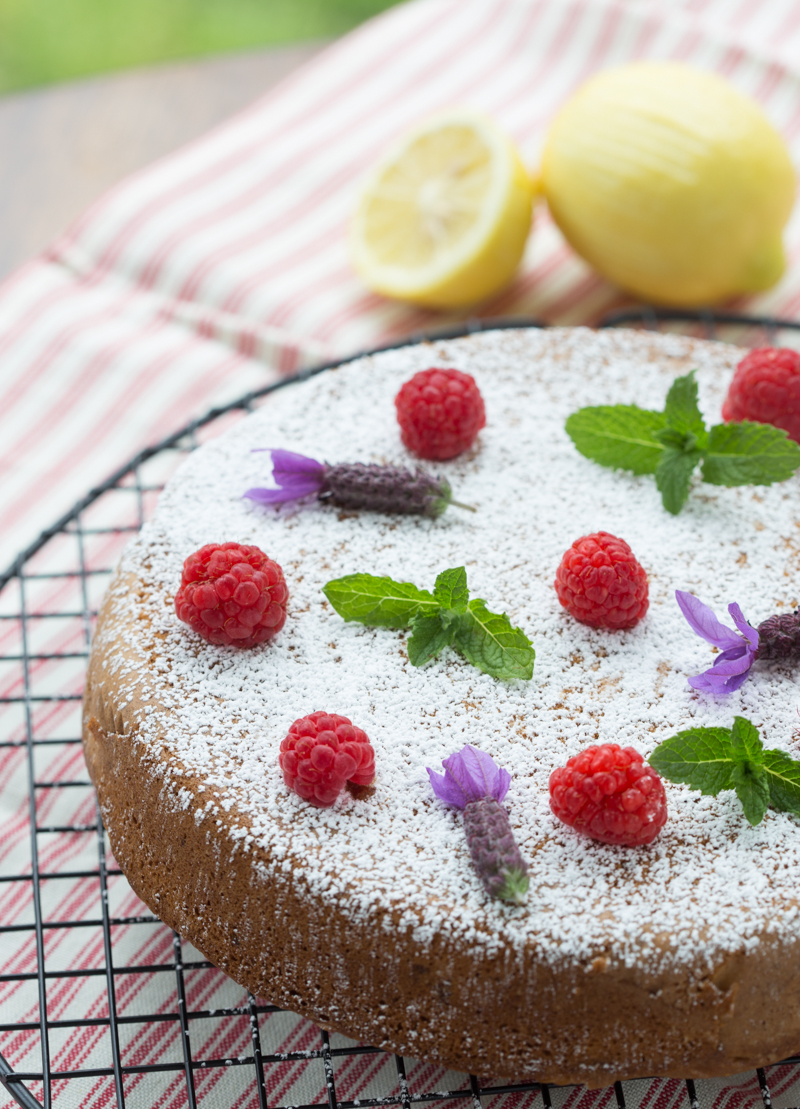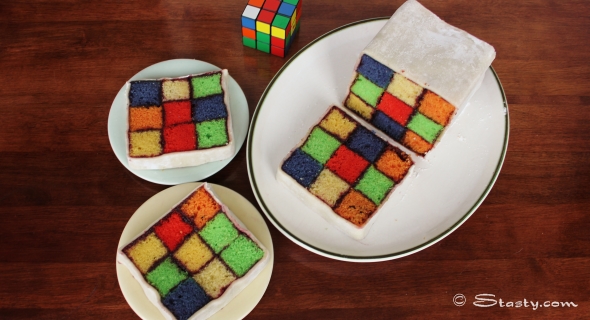
Update: On July 14th, two days after posting I received an email from Ernő Rubik himself saying that he liked my cake. I guess the world is really a very small place.
‘ Thanks for the nice birthday surprise which sweetens the bitterness of passing time.’
Hungarian Ernő Rubik invented the Rubik’s cube in 1974. He was born on the 13th of July, 1944. Myself and my other half set about making a birthday cake, worthy of the great man himself. Battenberg cakes are constructed of rectangular pieces of alternatively coloured Victoria sponge cake, sandwiched together by jam and held together with walls of marzipan. We decided that the different pieces of cake could by dyed the traditional six colours of the Rubik’s cube – white, red, blue, orange, green and yellow. Then to make the cake a little more Rubik’s like, we decided to have each slice of the cake reveal a different combination of coloured squares, just like a Rubik’s cube. To achieve this, we cut the coloured rectangles of sponge into different lengths. This was definitely a case where I needed the engineering mind of my other half to figure out the maths of this cake. It took a little planning to get it right, however I think it might just be a worthy birthday treat. I’m not sure if Ernő has a sweet tooth but hopefully he might enjoy this puzzling cake.
We wanted to add some flavour to the cakes and not have it all just taste of plain old sponge cake. So we flavoured the yellow sections of sponge with some grated lemon rind, the orange sections with orange rind and the pale sponge with almond essence. We had contemplated having all the colours taste of something different, for example flavour the green one mint and the red one strawberry. But we decided against it in the end, as there would be too many overwhelming flavours. So we stuck with just the orange, lemon and almond which complimented each perfectly.
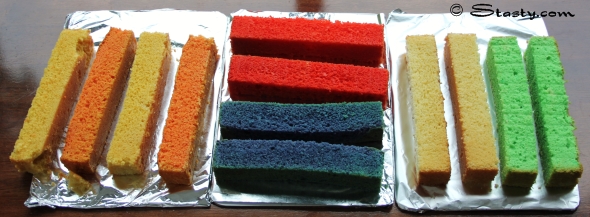
We essentially had to make three cakes which amounted to a whole pound of butter and over a jar of jam. It also took a lot of time to physically bake three cakes and wait for them to cool. But it was fun and I got a sort of childish glee when I saw all these multicoloured sections of cake coming out of the oven. Once the cake pieces had cooled, it was time for the grand assembly. We totally underestimated how much jam we would actually need to cement the whole thing together. But we eventually figured it all out. I began by rolling out a large sheet of marzipan which acted as a blanket to contain the bricks of cake.
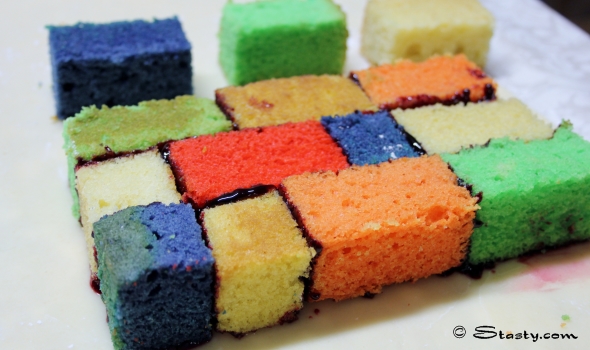
The cakes were then measured and cut into pieces before being glued together with sticky blackcurrant jam. We did it slowly, layer by layer. It was cool seeing it all come together like a house of cake. We then wrapped the marzipan around our masterpiece and stuck it together with yet more sticky jam! We let it settle overnight and cut it the next day.
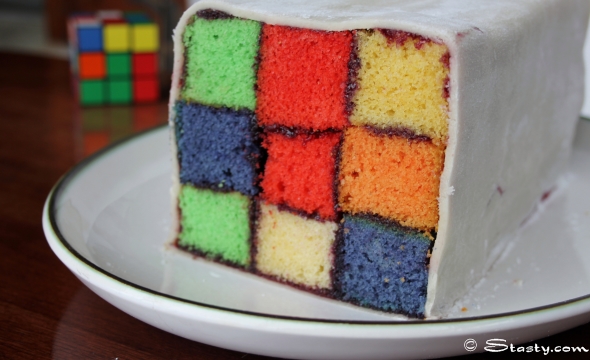
When I brought this cake into work people really didn’t what to make of it. It certainly caught people’s eye. Weirdly people ate cubes of it rather than slices which I thought was rather a nice way to eat cake. I think this cake would go down a storm at a kid’s party. However, I’m a kid from the eighties, so maybe it appeals more to big kids from my generation than kids of today.
Here’s how:
One Basic Battenberg
– 6 oz. of butter
– 6 oz. of castor sugar
– 3 eggs
– 6oz of self-raising flour
– few drops of food colouring (I used red, orange, green, blue and yellow)
(You will to make three basic Battenberg cakes for the Rubiks, using two colours per cake)
To finish
– I large pot of blackcurrant jam sieved
– 18oz of plain white marzipan to cover the entire cake.
– 2oz of icing sugar
For the yellow coloured cake, I added the grated rind of half a lemon. For the orange coloured cake I used the grated rind of half an orange. Finally for the plain sponge I used a few drops of almond essence and no food colouring to represent the white squares.
Pre-heat the oven 180 degrees Celsius. Grease and flour a Battenberg/ deep rectangular tin. My Battenberg tin was 8inches x 6inches and had 4 individual sections to put the different colours. If you are doing a cake of this size, it’s advisable to invest in a Battenberg tin as it makes the process very easy.
Cream together the butter and the sugar until it becomes light and creamy. Gradually add the beaten eggs. Then, carefully fold in the sieved flour. Take half of the mixture out, and place in another bowl. Add a few drops of food colouring to one batch. To the other half, add a few drops of a different food colouring. Spoon the mixture into the separate sections of the tin. Place in the oven for 30-35 minutes. To test if it’s ready place a clean knife through the centre, the knife should come out clean when it is fully cooked. If the cake rises over the tin, use a serrated knife to even off the top. Let the cake cool in the tin, once fully cooled, remove from the tin and place on a wire rack.
Repeat twice using the same method, ingredients and remaining food colours.
Once all the cakes are fully cool, you can now prepare to assemble. Place the jam in a saucepan and warm over a low heat. Next, sieve the warm jam into a seperate bowl.
Sprinkle the icing sugar onto a clean work surface. Place the marzipan on the surface and roll out to an even thickness. I rolled mine into a longer rectangle that I needed and cut off the excess at the end. With a pastry brush, paint the underside of the cake pieces with the warmed jam and continue building until all the cake has been used. Finish the top with another layer of jam before folding the marzipan over the cake and sealing the edges. Trim off the excess.

